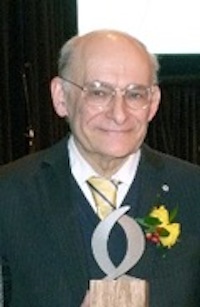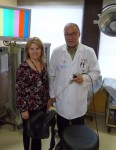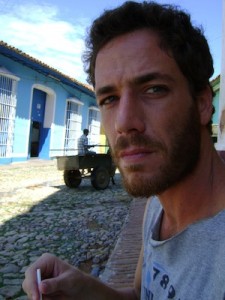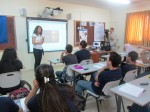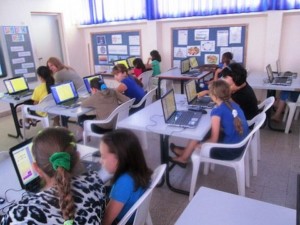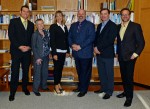Marie Doduck, third from the left, with her family. (photo by Cynthia Ramsay)
“Although the sheer number of Jews who perished in the Holocaust, six million, is seemingly beyond human comprehension, we must remember that each life snuffed out belonged to a person, an individual with a past, present and a promise of the future, a human being endowed with feelings, thoughts and dreams. Tonight, we light candles in memory of the six million Jews, one and a half million of whom were children … and in memory of the millions of other victims – we commemorate them as persons, as individuals.”
Ian Penn of the Second Generation set the tone, as master of ceremonies, for Vancouver Holocaust Education Centre’s Yom Hashoah commemoration on Monday, April 28. A standing-room-only crowd at the Jewish Community Centre of Greater Vancouver’s Wosk Auditorium attended.
Survivors from the local community lit candles in memory of all those who died. Chazzan Yaacov Orzech (Second Generation) chanted El Maleh Rachamim and survivor Chaim Kornfeld, the Kaddish. Dr. Moira Stilwell, MLA, spoke on behalf of the province.
“Those who cannot learn from history are doomed to repeat it,” she reminded the audience. “Yom Hashoah is not just about learning from history, but about passing those lessons on to the next generation. Today, we honor the six million voices that were silenced during the Holocaust, we mourn them, we remember them, and by remembering them, we pledge to never let genocide happen again. Today, we join together and speak for them.”
Penn spoke briefly, but movingly, of his mother, Lola, who died in January, just shy of her 92nd birthday. She survived the Holocaust but, as with most, not without sustaining great losses and witnessing much horror. Addressing his peers, he said, “We grew up with physical comforts but some strangeness and confusion, with marginal understanding and appreciation of the difficulty of becoming normal. Our parents, like Lola, clung to their traditions, confronted the modern, the world they were jettisoned into, their escape route, as best they could, and drove us forward to fulfil their stolen dreams…. Our parents, your parents, were, perhaps, no less complicated than Lola, at times positive and resilient, loving and strategic. And, just as likely, suspicious and threatening, ever vigilant and occasionally hyper-vigilant…. They had to create and re-create themselves, their fears, their terrors, opaque to us, whilst we, their prized possessions, were shepherded with passion … they were survivors in every sense of that word.”
Survivor Mariette Doduck spoke. “The person you see before you is Marie Doduck, a mother, a grandmother and a community volunteer. But there’s another me, Mariette Rozen. A frightened little girl, a tough kid, an enfant sauvage who lived through a lost childhood.” She was only three and a half years old, living in Brussels, when her “life was suddenly ripped apart and irrevocably changed by Nazis.”
In 1939, her family – she was the youngest of 11 – was separated. “We were put into peril by the fact of our Jewishness, a crime under the rule of Nazis’ Europe…. My mother had made a fatal mistake of following orders and registering us at the police station as of Jewish descent. She was told that, if she did, she would not be [taken] … nor would any of us. We had to run and vanish in order to survive. We children were separated and put into different homes. We became the children of silence, like robots, no talking, no crying, no disturbance, a blank mind, with no feelings and really no future. We lived in the moment, we felt nothing except hunger, feelings like loneliness were a luxury.”
Her mother and her brother Albert were murdered in Auschwitz. Doduck saw them being loaded into the trucks. “I had come out of hiding to celebrate my seventh birthday. I hadn’t seen my mother since I was three and a half years old. That was the last time I saw my mother and my brother alive.” Her brother Jean, part of the French Resistance, was hanged by the Gestapo; her brother Simon died three weeks after liberation – “after eating, from the mistaken kindness of the American and Canadian soldiers who liberated the concentration camps and fed the fragile, thin and starving prisoners food that they could no longer digest.”
To survive, Doduck hid with non-Jewish families and in orphanages, took refuge in storm sewers, cellars, as well as in a hayloft, from which she bears a scar from a pitchfork wielded by a Nazi soldier looking for Jews. “I lived mostly in darkness, literally.” When she returned to Brussels years later, she said, she couldn’t recognize it in the light.
“I became tough and streetwise and, because of my young age and my unusual photographic memory, I was used as a messenger in the French Underground. I was even smuggled into a prison to pass a message into my sister Sarah…. Like a fugitive, I lived in fear and confusion in more than one country…. The people I lived with often beat me, and often treated me like a slave … even though they were paid by my family to keep me in hiding. There were also those that risked their lives to save me.” Among them, a convent’s mother superior and a German friend of Doduck’s brother.
Doduck recalled a friend’s death. Savagely beaten, the girl died in her arms. “If I had not forgotten to make my bed and, therefore, been forbidden to go outside [the convent],” said Doduck, she, too, would have been killed.
Doduck also experienced illness, one in which pustules covered her whole body; her skin had to be scrubbed with sulfur. “Despite this sickness and all of the physical and mental anguish, I, like millions of others, did survive, not unscarred, and, in a sense, wise for it. In a perverse way, perhaps, one could even say that I was fortunate because I have seen both sides of humanity.”
“It was only with great pressure from the Jewish community … [that, eventually] 1,123 Jewish orphan children and young adults were brought out of wartorn Europe to make a new life in Canada.”
Reading the book None Is Too Many, Doduck said she had to put it down often, so angered was she that such attitudes existed in Canada as well, “attitudes that nearly kept me, my brothers and sisters out of Canada. People like Prime Minister Mackenzie King and his sidekick Mr. [Frederick] Blair, then director of immigration, did everything in their power at that time to keep Jews out of Canada, even orphan refugee children. It was only with great pressure from the Jewish community,” she said, that, eventually, “1,123 Jewish orphan children and young adults were brought out of wartorn Europe to make a new life in Canada.”
Doduck was one of those children. “When I first started to tell people what had happened to me, they said, ‘Forget about the past.’ But I say to you, I learned from my experiences, both good and bad. Whatever we experience in life contains a message. God provides these vehicles, however painful. It is up to us to interpret and accept them. This we can choose to do either positively or negatively. Without sounding immodest, I had the courage, even as a child, to go on despite the feeling of mistrust, fear, pain and loathing. These lessons are in a significant way responsible for who I am today.”
Doduck arrived here in 1947, 12 years old and, once again, “plunged into a world of strangers.” Here, she said, “I saw goodness in people that I shall never forget, and that’s my adoptive family, Joe and Minnie Satanov and many other wonderful families that took in children of the Holocaust across Canada.”
The Satanovs raised Doduck as their daughter. They bought her first bike, her first pair of skates and many other such things. “You’ve got to understand, we survivors had no toys to play with, we had no blanket to hold on to, we had nothing…. Through their patience and love and understanding, they brought me back to my Jewishness and gave me back my humanity.” But it wasn’t easy, and she ran away from home many times in the first year. “How can you understand how angry, hurt, lonely I was, missing my own mother, brothers, sisters?”
With the Satanovs’ love and support, Doduck graduated high school. “I entered the business working world and eventually met my husband, whom they liked and, as good parents would do, they paid for our wedding. They are both at rest now, but the memory of them is forever ingrained in my heart and in my daughters’, who loved them as grandparents.”
Although encouraged to hide her Jewish identity during the war, between her brother’s reminders that she must remain Jewish and memories of her mother, for example, lighting Shabbat candles (her father died when she was a toddler), Doduck said, “My Jewishness was always part of me…. Now, I take pride in passing this on to my children and grandchildren, unafraid and unabashed, to show and teach them what it is to be … proud of their heritage. Yet, the future is not assured for them. What happened to me and to millions of innocents could happen again … we have the obligation to tell the world the horror of the Holocaust, to teach our children, and they to theirs, so that the past will not repeat itself.”
The hurt will never go away, but life for her has been “a step-by-step process, not something to take for granted, but to fight for. We turned out, survivors, we turned out [to be] decent people that help other people. We are involved in whatever is good: fighting hatred, fanaticism and racism. Although our childhood has been robbed from us – look what we have achieved.”
“I read that the truth is not only violated by falsehood, it may be equally outraged by silence. And I refuse to be silent. Future generations must know and learn. This must be done, however painful. It is our sacred duty – prejudice, hatred, racism, antisemitism have no place in our society.”
She warned, however, that there “are many who are now denying the Holocaust and so we must bear witness…. Because we survived, we have a duty, an obligation, to see to it that these truths are not forgotten…. I read that the truth is not only violated by falsehood, it may be equally outraged by silence. And I refuse to be silent. Future generations must know and learn. This must be done, however painful. It is our sacred duty – prejudice, hatred, racism, antisemitism have no place in our society.
“Tonight, we meet to mark Yom Hashoah, presented by Vancouver Holocaust Education Centre, of which I’m a founding member. I have spoken to countless groups of students about my experiences as a Holocaust survivor. Not everyone can understand how extremely painful it is for me, for us, to remember things I would rather forget. But we do it, I do it, regardless of the sleepless nights that follow. I do it because I know that education is the only key to prevention.”
Doduck concluded, “When I speak to young people, I speak as a child, Mariette; tonight, to you, as a peer, Marie. Yet, standing here before you, I find that I cannot separate the two so easily. But maybe these two different people, one that witnessed the horrors of the Holocaust and the other an active citizen in our community, are essential in the present day: essential to the remembrance of the Shoah and essential to working to ensure that it will never happen again.”
Throughout the evening, musical selections were performed by Claire Klein Osipov or members of an ensemble that included Gil Ashkenazy, Megan Emanuel, Samantha Gomberoff (Fourth Generation), Maya Kallner, Sasha Kaye, Jared Khalifa; Kathryn Rose Palmer, Brian Riback, Talya Kaplan Rozenberg, Ayla Tesler-Mabe and Lorenzo Tesler-Mabe, all of the Third Generation. Wendy Bross Stuart, who produced the evening with husband Ron Stuart, was on piano, Eric Wilson on cello. The organizing committee was Cathy Golden, Ethel Kofsky and Rome Fox, all of the Second Generation.


